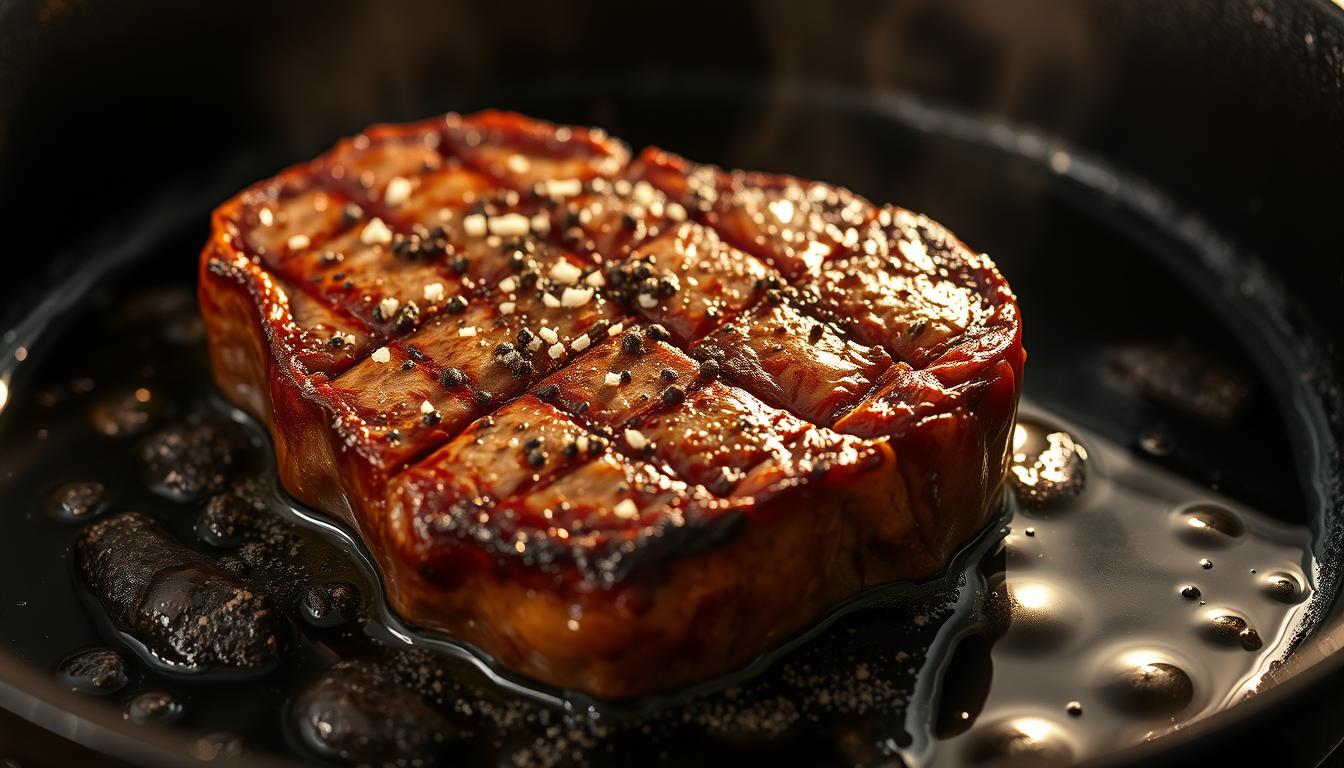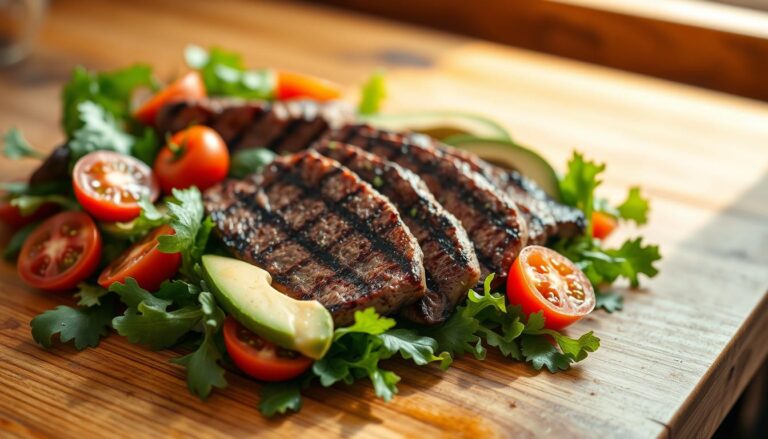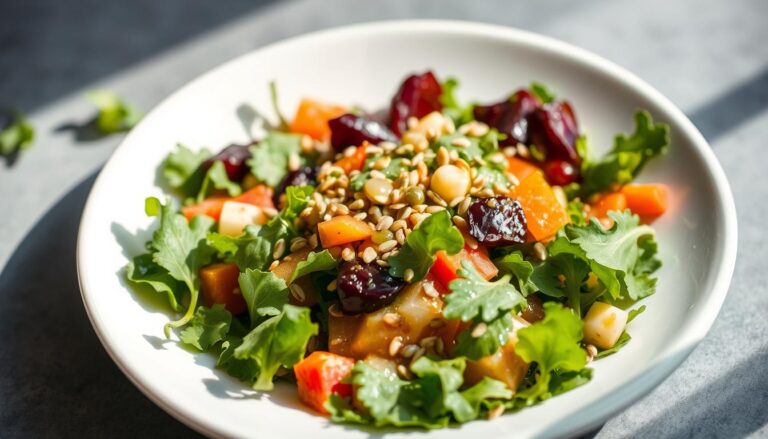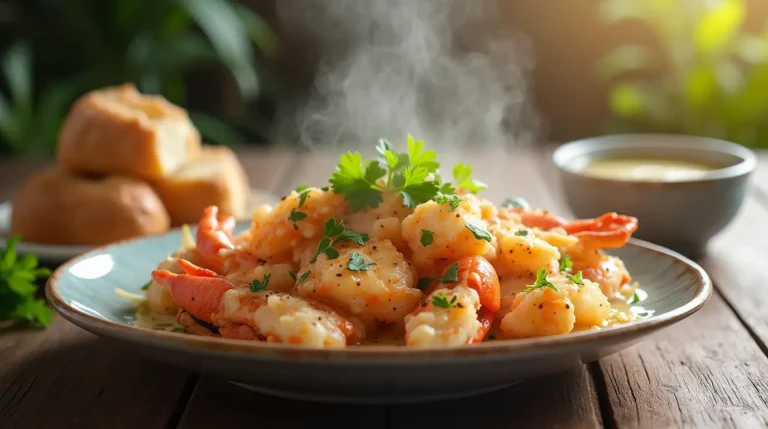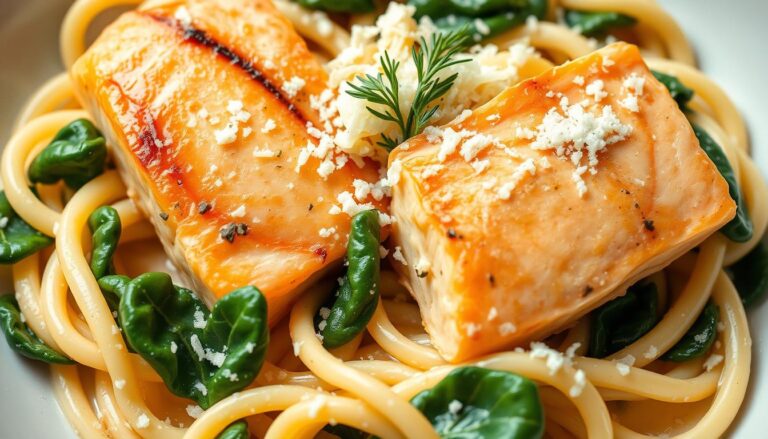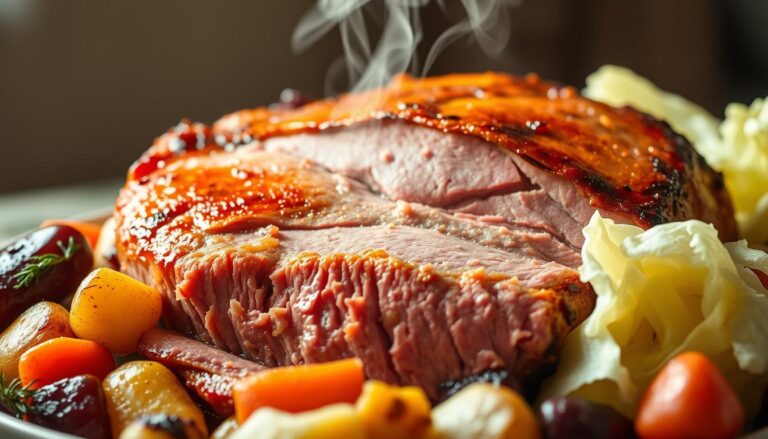Flat Iron Steak Recipe: Tips for Perfect Cooking
The first time I sliced into a perfectly cooked flat iron steak, I knew something magical had happened in my kitchen. That moment of culinary triumph changed how I cook beef forever. Your journey with flat iron steak recipes is about to become an unforgettable culinary adventure.
Cooking flat iron steak is more than just preparing a meal—it’s about creating an experience. This versatile cut offers incredible flavor and tenderness when cooked right. Whether you’re a weekend grilling enthusiast or a serious home chef, mastering the flat iron steak recipe will open up a world of delicious possibilities.
In this comprehensive guide, you’ll learn expert tips for cooking flat iron steak. From picking the perfect cut to achieving restaurant-quality results, we’ll cover every essential step. This will ensure your steak is nothing short of spectacular.
Table of Contents
Understanding Flat Iron Steak: A Premium Cut
The flat iron steak is a favorite among beef lovers. It’s known for its great taste and softness. This steak comes from the cow’s shoulder, making it special and in demand.
This cut stands out because of its unique qualities. It’s perfect for those who love cooking and eating meat. Let’s look at what makes this steak so special.
What Makes Flat Iron Steak Special
The flat iron steak is loved for many reasons:
- It has great marbling for a rich flavor
- It’s very tender
- It can be cooked in many ways
- It’s also more affordable than some other cuts
Anatomy and Marbling Features
The marbling in flat iron steak is key to its taste. It’s found in the shoulder blade area. This fat melts when cooked, making the steak juicy and tasty.
Choosing Quality Flat Iron Steak
When picking a good flat iron steak, consider these points:
- Look for even marbling in the meat
- Choose steaks with a bright red color
- They should feel firm and not too wet
- Buy from trusted butchers or meat shops
A high-quality flat iron steak will show white fat lines. This means it has great marbling and will taste amazing.
Essential Tools and Equipment for Preparation
To make the perfect flat iron steak, you need more than just good meat. Your cooking tools are key to getting that restaurant-quality taste. Let’s look at the must-have tools for cooking a great flat iron steak.
- Precision Meat Thermometer: It’s vital for checking the steak’s internal temperature. This ensures it’s cooked just right for you.
- Heavy-Duty Cast Iron Skillet: It cooks evenly and gives that golden-brown crust everyone loves.
- Sharp Trimming Knife: It’s for cutting the meat precisely. This helps remove any fat you don’t want.
- Quality Tongs: They let you handle and flip the steak safely. This way, you avoid piercing the meat.
Getting professional-grade cooking tools can really improve your home cooking. A good meat thermometer stops overcooking. A cast iron skillet keeps heat well, making a tasty sear.
When picking your steak tools, think about how durable and useful they are. Stainless steel utensils, digital thermometers, and seasoned cast iron skillets are your go-to tools for amazing steaks.
Pro tip: Always choose tools that feel comfortable and balanced in your hand for the best cooking experience.
Preparing Your Flat Iron Steak Recipe
Mastering flat iron steak starts with careful prep and detail. Success comes from key steps that make a great meal.
Seasoning flat iron steak is more than salt and pepper. The prep affects taste and texture.
Trimming and Seasoning Guidelines
Here are essential trimming tips for flat iron steak:
- Remove silver skin and tough tissue
- Use a sharp knife for clean cuts
- Leave a thin fat layer for flavor
Marinades and Rubs Options
Try these marinades to enhance your steak:
| Marinade Type | Key Ingredients | Marinating Time |
|---|---|---|
| Classic Herb | Rosemary, thyme, garlic, olive oil | 2-4 hours |
| Spicy Southwest | Chili powder, cumin, lime juice | 1-2 hours |
| Asian-Inspired | Soy sauce, ginger, sesame oil | 30 minutes-2 hours |
Room Temperature Tips
Bringing your steak to room temperature is key for even cooking. Remove the steak from the fridge 30-45 minutes before cooking. This ensures even heat and perfect doneness.
“A well-prepared steak starts long before it hits the grill” – Professional Chef’s Wisdom
By using these prep techniques, you’ll make a steak that wows every time.
Best Cooking Methods for Tender Results
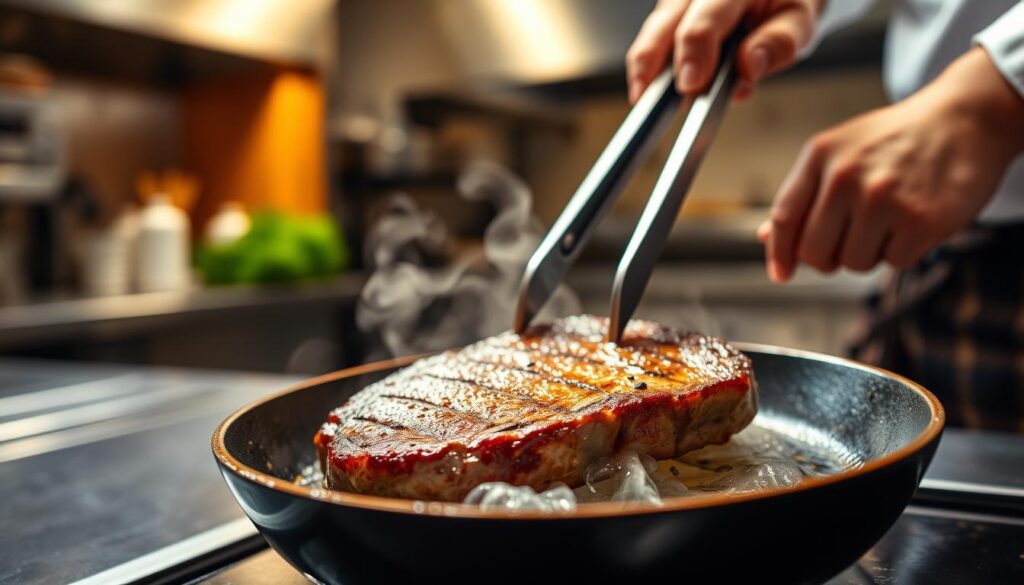
Learning to cook flat iron steak right is key. You need to know the best ways to keep it tender. Each method has its own benefits for a tasty meal that highlights the steak’s flavor and texture.
Grilling: The Classic Approach
Grilling is a favorite for cooking flat iron steak. It gives a nice caramelized outside and a juicy inside. Here’s how to do it:
- Preheat grill to high temperature (450-500°F)
- Pat steak dry with paper towels
- Season generously with salt and pepper
- Grill 4-5 minutes per side for medium-rare
Pan-Searing: Indoor Perfection
If you can’t grill outside, pan-searing is a great indoor option. A cast-iron skillet is best for a crispy crust.
- Use high smoke-point oil like avocado or grapeseed
- Heat skillet until smoking hot
- Sear 3-4 minutes per side
- Baste with butter for extra flavor
Broiling: Quick and Easy Method
Broiling is a fast way to cook flat iron steak. Place the oven rack near the broiler and watch it closely to avoid overcooking.
| Cooking Method | Cooking Time | Difficulty Level |
|---|---|---|
| Grilling | 8-10 minutes | Intermediate |
| Pan-Searing | 6-8 minutes | Easy |
| Broiling | 5-7 minutes | Beginner |
No matter the method, the secret to a tender steak is not to overcook it. Always use a meat thermometer. Take the steak out of the heat when it’s 5 degrees below your desired doneness.
Temperature Guide and Cooking Times
Mastering flat iron steak cooking needs precision and knowing how to control temperature. Success comes from watching the internal temperature closely to get the perfect doneness.
It’s key to know the right temperature for flat iron steak to make a tasty meal. Each doneness level has a specific internal temperature. This changes the meat’s texture and taste.
Steak Doneness Chart
| Doneness Level | Internal Temperature | Appearance |
|---|---|---|
| Rare | 125°F | Cool red center |
| Medium Rare | 135°F | Warm red center |
| Medium | 145°F | Pink center |
| Medium Well | 150°F | Slight pink center |
| Well Done | 160°F | No pink |
Internal Temperature Monitoring
Use a meat thermometer to check the steak’s internal temperature. Put the thermometer sideways in the thickest part for the best reading. Digital thermometers give quick and accurate results.
Resting Steak Guidelines
Resting the steak is crucial for keeping it juicy and flavorful. After cooking, let it rest for 5-10 minutes. This lets the juices spread out, making the steak tender and juicy.
- Remove steak from heat source
- Place on a cutting board
- Tent loosely with aluminum foil
- Wait 5-10 minutes before slicing
Pro tip: The steak’s temperature will rise a bit while it rests. So, take it off the heat just before it reaches your desired doneness.
Common Mistakes to Avoid When Cooking
Cooking a perfect flat iron steak needs skill and focus. Many home cooks make mistakes that can spoil a great piece of meat. Knowing these mistakes can improve your cooking and make your meal taste like it’s from a restaurant.
- Skipping the Meat Preparation: Not letting your steak warm up before cooking can cause uneven cooking. Cold meat cooks unevenly, making it tough and not tasty.
- Incorrect Seasoning Technique: Too much salt or not enough can change the steak’s taste. Salt your steak well about 40 minutes before cooking to let it soak up the flavor.
- Using the Wrong Cooking Temperature: High heat is key for a perfect sear. Low heat stops the steak from getting that tasty crust.
Many cooking mistakes come from being too quick. People often rush or handle the meat wrong, which makes the steak bad. The secret is to cook your flat iron steak carefully and with precision.
| Mistake | Consequence | Solution |
|---|---|---|
| Overcooking | Dry, tough meat | Use meat thermometer, remove at 5°F below desired temperature |
| Not Resting Meat | Loss of juices | Let steak rest 5-10 minutes after cooking |
| Slicing Incorrectly | Tough, chewy texture | Cut against the grain |
Professional chefs know that mastering flat iron steak takes practice and focus. By avoiding these common mistakes, you can turn your home-cooked meal into a culinary masterpiece.
Serving Suggestions and Pairings
Improving your flat iron steak experience is more than just cooking it right. The right pairings and presentation can turn a simple meal into a memorable event. To master flat iron steak pairings, focus on flavor profiles, drinks, and plating techniques.
Wine and Beverage Recommendations
Choosing the perfect drink can boost your steak’s flavor. For red wines, consider these top pairings:
- Cabernet Sauvignon: Bold and full-bodied
- Malbec: Rich with robust flavor
- Syrah: Spicy undertones complement the meat
For those who prefer not to drink wine, craft beer or bourbon can be great alternatives. They match the steak’s intense flavor well.
Steak Side Dish Options
Pair your flat iron steak with side dishes that balance and enhance it:
- Roasted garlic mashed potatoes
- Grilled asparagus with lemon zest
- Caramelized Brussels sprouts
- Creamy blue cheese risotto
Plating Steak with Professional Techniques
Presentation is as important as taste. Use these techniques to make your dish look like it’s from a restaurant:
- Slice the steak against the grain
- Use white plates to highlight the meat’s color
- Create height with strategic side dish placement
- Garnish with fresh herbs for a pop of color
Pro tip: Let your steak rest for 5-7 minutes before slicing. This ensures it stays juicy and looks stunning.
Storage and Leftover Tips
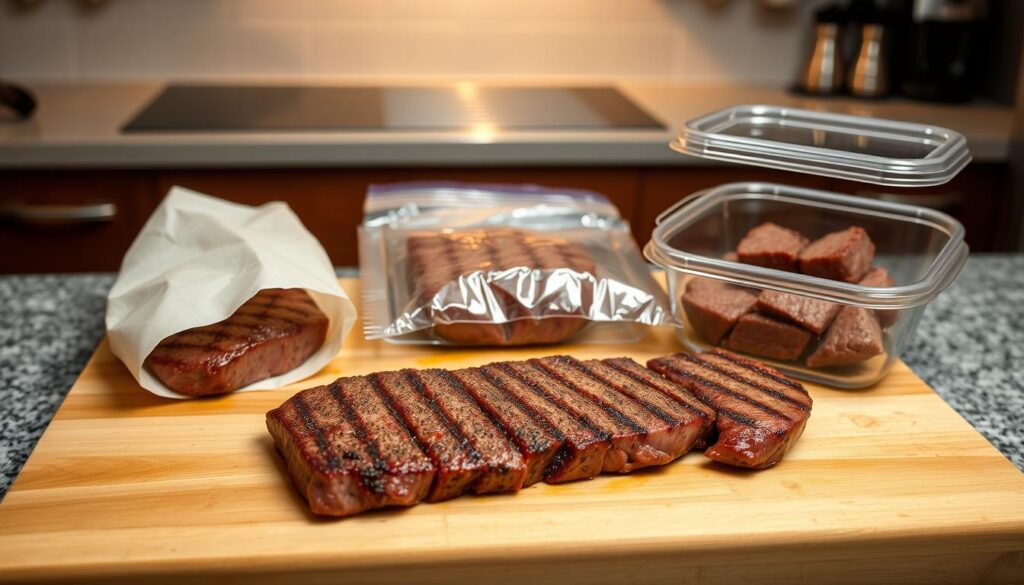
Storing cooked steak properly can make your leftover flat iron steak even better. Keeping it in the fridge is crucial. It helps keep the meat fresh and stops bacteria from growing.
Here are some key tips for storing flat iron steak leftovers:
- Cool the steak to room temperature within 2 hours of cooking
- Wrap the steak tightly in aluminum foil or plastic wrap
- Store in an airtight container to prevent moisture loss
- Refrigerate at 40°F or below
Your leftover flat iron steak can stay fresh in the fridge for 3-4 days. If you want to keep it longer, freezing is a great choice.
| Storage Method | Maximum Storage Time | Best Practices |
|---|---|---|
| Refrigerator | 3-4 days | Wrap tightly, use airtight container |
| Freezer | 2-3 months | Use freezer-safe bag, remove excess air |
When you reheat your leftover steak, do it gently. This prevents it from drying out. Try using a low oven or a microwave with a damp paper towel to keep it moist.
“The secret to great leftover steak is proper storage and careful reheating.” – Professional Chef
There are many ways to use leftover steak. Slice it for salads, add it to stir-fries, or make tasty sandwiches. These ideas can make your original meal even better.
Conclusion
Mastering flat iron steak is an art that combines technique, passion, and practice. You’ve now learned the essential skills to transform this premium cut into a restaurant-quality meal right in your own kitchen. The perfect steak recipe isn’t just about following steps – it’s about understanding the nuances of cooking and developing your culinary intuition.
Every great chef starts with knowledge and builds confidence through experience. Your journey with flat iron steak will involve experimenting with different seasonings, exploring various cooking methods, and discovering your personal preferences. Remember that temperature control, proper preparation, and careful technique are the cornerstones of creating an exceptional steak.
With the techniques you’ve learned, you’re equipped to elevate your home cooking and impress family and friends. Whether you prefer a perfectly seared medium-rare or a well-done cut, your understanding of flat iron steak preparation will shine through in every bite. Keep practicing, stay curious, and enjoy the delicious results of your newfound skills.
Your culinary adventure doesn’t end here – it’s just beginning. Embrace the process, trust your instincts, and savor the journey of becoming a true steak preparation expert.
FAQ
What is a flat iron steak and where does it come from?
How long should I marinate a flat iron steak?
What is the best cooking method for flat iron steak?
How do I know when my flat iron steak is cooked to the right temperature?
Can I freeze flat iron steak?
What are some recommended side dishes for flat iron steak?
How should I slice a flat iron steak?
What wine pairs well with flat iron steak?
How can I prevent my flat iron steak from becoming tough?
Can I use flat iron steak for other recipes?
We’d Love to Hear Your Sweet Feedback!
There are no reviews yet. Be the first one to write one.

